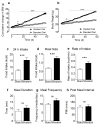Peripheral endocannabinoid signaling controls hyperphagia in western diet-induced obesity
- PMID: 28065722
- PMCID: PMC5296283
- DOI: 10.1016/j.physbeh.2016.12.044
Peripheral endocannabinoid signaling controls hyperphagia in western diet-induced obesity
Abstract
The endocannabinoid system in the brain and periphery plays a major role in controlling food intake and energy balance. We reported that tasting dietary fats was met with increased levels of the endocannabinoids, 2-arachidonoyl-sn-glycerol (2-AG) and anandamide, in the rat upper small intestine, and pharmacological inhibition of this local signaling event dose-dependently blocked sham feeding of fats. We now investigated the contribution of peripheral endocannabinoid signaling in hyperphagia associated with chronic consumption of a western-style diet in mice ([WD] i.e., high fat and sucrose). Feeding patterns were assessed in male C57BL/6Tac mice maintained for 60days on WD or a standard rodent chow (SD), and the role for peripheral endocannabinoid signaling at CB1Rs in controlling food intake was investigated via pharmacological interventions. In addition, levels of the endocannabinoids, 2-AG and anandamide, in the upper small intestine and circulation of mice were analyzed via liquid chromatography coupled to tandem mass spectrometry to evaluate diet-related changes in endocannabinoid signaling and the potential impact on food intake. Mice fed WD for 60days exhibited large increases in body weight, daily caloric intake, average meal size, and rate of feeding when compared to control mice fed SD. Inhibiting peripheral CB1Rs with the peripherally-restricted neutral cannabinoid CB1 receptor antagonist, AM6545 (10mg/kg), significantly reduced intake of WD during a 6h test, but failed to modify intake of SD in mice. AM6545 normalized intake of WD, average meal size, and rate of feeding to levels found in SD control mice. These results suggest that endogenous activity at peripheral CB1Rs in WD mice is critical for driving hyperphagia. In support of this hypothesis, levels of 2-AG and anandamide in both, jejunum mucosa and plasma, of ad-libitum fed WD mice increased when compared to SC mice. Furthermore, expression of genes for primary components of the endocannabinoid system (i.e., cannabinoid receptors, and endocannabinoid biosynthetic and degradative enzymes) was dysregulated in WD mice when compared to SC mice. Our results suggest that hyperphagia associated with WD-induced obesity is driven by enhanced endocannabinoid signaling at peripheral CB1Rs.
Keywords: 2-AG; Anandamide; Endocannabinoid; Obesity; Peripheral; Western diet.
Copyright © 2017 Elsevier Inc. All rights reserved.
Figures




Similar articles
-
Cholinergic Neurotransmission Controls Orexigenic Endocannabinoid Signaling in the Gut in Diet-Induced Obesity.J Neurosci. 2024 May 15;44(20):e0813232024. doi: 10.1523/JNEUROSCI.0813-23.2024. J Neurosci. 2024. PMID: 38594069 Free PMC article.
-
Cannabinoid CB1 Receptors in the Intestinal Epithelium Are Required for Acute Western-Diet Preferences in Mice.Nutrients. 2020 Sep 20;12(9):2874. doi: 10.3390/nu12092874. Nutrients. 2020. PMID: 32962222 Free PMC article.
-
A peripheral mechanism for CB1 cannabinoid receptor-dependent modulation of feeding.J Neurosci. 2002 Nov 1;22(21):9612-7. doi: 10.1523/JNEUROSCI.22-21-09612.2002. J Neurosci. 2002. PMID: 12417686 Free PMC article.
-
The endocannabinoid-CB receptor system: Importance for development and in pediatric disease.Neuro Endocrinol Lett. 2004 Feb-Apr;25(1-2):24-30. Neuro Endocrinol Lett. 2004. PMID: 15159678 Review.
-
Endocannabinoids, feeding and suckling--from our perspective.Int J Obes (Lond). 2006 Apr;30 Suppl 1:S24-8. doi: 10.1038/sj.ijo.0803274. Int J Obes (Lond). 2006. PMID: 16570101 Review.
Cited by
-
The Endocannabinoid System and Physical Activity-A Robust Duo in the Novel Therapeutic Approach against Metabolic Disorders.Int J Mol Sci. 2022 Mar 12;23(6):3083. doi: 10.3390/ijms23063083. Int J Mol Sci. 2022. PMID: 35328503 Free PMC article. Review.
-
Role of the Endocannabinoid System in the Adipose Tissue with Focus on Energy Metabolism.Cells. 2021 May 21;10(6):1279. doi: 10.3390/cells10061279. Cells. 2021. PMID: 34064024 Free PMC article. Review.
-
Cannabis: From a Plant That Modulates Feeding Behaviors toward Developing Selective Inhibitors of the Peripheral Endocannabinoid System for the Treatment of Obesity and Metabolic Syndrome.Toxins (Basel). 2019 May 15;11(5):275. doi: 10.3390/toxins11050275. Toxins (Basel). 2019. PMID: 31096702 Free PMC article. Review.
-
Endocannabinoids in Body Weight Control.Pharmaceuticals (Basel). 2018 May 30;11(2):55. doi: 10.3390/ph11020055. Pharmaceuticals (Basel). 2018. PMID: 29849009 Free PMC article. Review.
-
Re-visiting the Endocannabinoid System and Its Therapeutic Potential in Obesity and Associated Diseases.Curr Diab Rep. 2017 Sep 14;17(10):99. doi: 10.1007/s11892-017-0924-x. Curr Diab Rep. 2017. PMID: 28913816 Review.
References
-
- Medina-RemOn A, Kirwan R, Lamuela-Raventos RM, Estruch R. Dietary Patterns and the Risk of Obesity, Type 2 Diabetes Mellitus, Cardiovascular Diseases, Asthma, and Mental Health Problems. Crit Rev Food Sci Nutr. 2016:0. - PubMed
Publication types
MeSH terms
Substances
Grants and funding
LinkOut - more resources
Full Text Sources
Other Literature Sources
Medical
Miscellaneous

